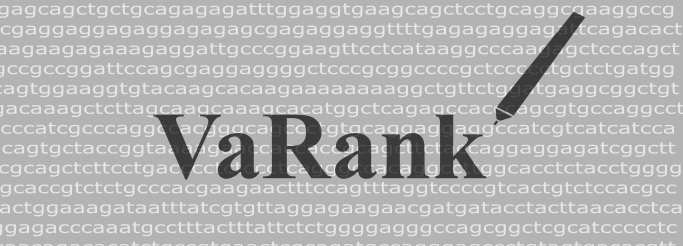

| Home | News | Downloads | Examples & Tutorial | FAQ | Collaborations and citations | How to cite | Contact |
Q: How to cite VaRank in your work?
A: If you are using VaRank, please cite our work using the following reference:
Geoffroy V.*, Pizot C.*, Redin C., Piton A., Vasli N., Stoetzel C., Blavier A., Laporte J. and Muller J.
VaRank: a simple and powerful tool for ranking genetic variants.
PeerJ. 2015. in press.(10.7717/peerj.796)
Q: What are the WARNINGs that VaRank mention while running?
A: VaRank writes to the standard output progress of the analysis including warnings about issues or
missing information that can be either blocking or simply informative. More specifically while loading
the VCF file(s) specific information are under survey such as vcf format consistency, patient
redundancy, the total and variant read depth, the genotype, the indels. Any surveyed default will be
reported to the user.
Q: I want to run a VaRank analysis again, what shall I do?
A: Simply remove all output files (*.tsv) and type the new command line. All annotations will be kept
and the analysis should be done very quickly.
Q: I have already computed 5 samples in my analysis and I want to add 10 more, what should I do?
A: Considering no updated version of any annotation source or VaRank available, you can simply add
the new vcf files to the already computed ones, remove all output files (*.tsv), remove simply the
/Alamut/AlamutInputFile_all.txt (that will be recreated with the new variants if any) (and PPH2 input
file if PPH2 is installed) and rerun VaRank. VaRank will only recompute the missing annotations and will
save you the computation time of reannotating multiple times the same variants.
Q: How are the variant homozygous or heterozygous status reported?
A: VaRank trust by default the zygosity status provided by the vcf and report this in the column
"Zigosity" in the output files. Nonetheless, in the case when no data is provided but total and variant
depth of coverage is available, VaRank recompute this by applying the simple rule everything
>=Homcutoff (default 80% see options) is homozygous and the rest is heterozygous. In order to clearly
show difference with other variants those recomputed will be noted "hom?" or "het?". The same rule
is applied when using the option "-Homstatus" except that variant are noted "hom" or "het".
Q: In the output files some values are set to "NA"?
A: When for a specific type of annotation no information is available then the empty value is set to
"NA" (e.g. Not Available). Exception is made for several numerical columns (including rsMAF,
gnomAD frequencies...) where "-1" is used that allows the user to further filter information
without losing data.
Q: What PolyPhen2 prediction are running?
A: Depending on the annotation engine PPH2 either needs to be installed separately (Alamut Batch)
or is already integrated (SnpEff). Nevertheless one can still have SnpEff installed and a local installation of
PPH2. If the 2 programs are installed and properly setup for the use in VaRank, despite the fact that SnpEff
annotations might already contain PPH2 predictions, the local PPH2 installation will be used. If this is not your
intention simply unset PPH2 environment variable.
Q: If SNPEFF and ALAMUT environment variables are both set, what annotation engine is running?
A: By default, ALAMUT annotation engine is used.
Q: Why can we have several genes in the annotation of one variation?
In some cases, one variation can be annotated using several genes. This happens when overlapping genes exist.
VaRank selects the most pathogenic annotation and thus the first gene described is the one corresponding to this situation.
VaRank keep all the other gene names. In the following example, BBS1 is the gene in consideration for the annotation of
the considered variation but as indicated in the column "Gene" there is a second gene that is DPP3:11_66277969_C_T BBS1/DPP3